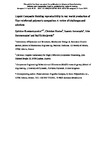Liquid Composite Moulding reproducibility in real world production of fiber reinforced polymeric composites: a review of challenges and solutions
| dc.contributor.author | Konstantopoulos, S | |
| dc.contributor.author | Hueber, C | |
| dc.contributor.author | Antoniadis, I | |
| dc.contributor.author | Summerscales, John | |
| dc.contributor.author | Schledjewski, R | |
| dc.date.accessioned | 2019-06-21T11:31:56Z | |
| dc.date.issued | 2019-07-01 | |
| dc.identifier.issn | 2055-0359 | |
| dc.identifier.issn | 2055-0359 | |
| dc.identifier.uri | http://hdl.handle.net/10026.1/14353 | |
| dc.description.abstract |
Liquid composite molding (LCM) suffers from multiple factors that contribute to pronounced uncertainty of process characteristics. This results in compromised reproducibility which is associated to high scrap or the unpredictable behavior of approved parts. However, LCM is still attractive for Fiber-reinforced polymeric composites (FRPC) production due to its economic advantage (i.e. in relation to Autoclave), the capability of some of its variants to produce high performance parts and its potential for process optimization. This review analyzes each uncertainty with respect to its origins and its impact in part or process, based on a combination of past literature and original numerical results. The possible methods to counteract uncertainties are critically discussed, with an eye on both the scientific and feasibility (technical/economical) aspects. The overall aim is to provide to future LCM implementations a roadmap of the most critical challenges and solutions regarding the establishment of a reproducible process. | |
| dc.format.extent | 85-99 | |
| dc.language | en | |
| dc.language.iso | en | |
| dc.publisher | Taylor & Francis Group | |
| dc.title | Liquid Composite Moulding reproducibility in real world production of fiber reinforced polymeric composites: a review of challenges and solutions | |
| dc.type | journal-article | |
| dc.type | Review | |
| dc.type | Journal | |
| plymouth.issue | 3 | |
| plymouth.volume | 5 | |
| plymouth.publication-status | Published | |
| plymouth.journal | Advanced Manufacturing: Polymer and Composites Science | |
| dc.identifier.doi | 10.1080/20550340.2019.1635778 | |
| plymouth.organisational-group | /Plymouth | |
| plymouth.organisational-group | /Plymouth/Faculty of Science and Engineering | |
| plymouth.organisational-group | /Plymouth/Faculty of Science and Engineering/School of Engineering, Computing and Mathematics | |
| plymouth.organisational-group | /Plymouth/REF 2021 Researchers by UoA | |
| plymouth.organisational-group | /Plymouth/REF 2021 Researchers by UoA/UoA12 Engineering | |
| plymouth.organisational-group | /Plymouth/Research Groups | |
| plymouth.organisational-group | /Plymouth/Research Groups/Marine Institute | |
| plymouth.organisational-group | /Plymouth/Users by role | |
| plymouth.organisational-group | /Plymouth/Users by role/Academics | |
| dcterms.dateAccepted | 2019-03-20 | |
| dc.rights.embargodate | 2019-7-5 | |
| dc.identifier.eissn | 2055-0359 | |
| dc.rights.embargoperiod | Not known | |
| rioxxterms.versionofrecord | 10.1080/20550340.2019.1635778 | |
| rioxxterms.licenseref.uri | http://www.rioxx.net/licenses/all-rights-reserved | |
| rioxxterms.licenseref.startdate | 2019-07-01 | |
| rioxxterms.type | Journal Article/Review |


